Grenades
28/07/2011 12:39
NOTE:
This information is for educational purposes only. Anyone practising this is at his/her own risk
Hand Grenades
DESCRIPTION
Hand grenades can be classified as:
-
Fragmentation. These grenades are used to produce casualties by high velocity projection of fragment. Historically, the most important hand grenade has been the fragmentation grenade, which is the soldier's personal indirect weapon system.
Fragmentation grenades are fused with either impact detonating or delay detonating fuzes composed of a striker, primer and delay charge detonator. A booster may be included. A safety lever, curved to conform to the shape of the grenade body, is hooked to the top of the fuze. The lever is held in place by a safety pin (pull ring), which protects the striker from action of the striker spring. Safety pin removal is required immediately before the grenade is thrown.
-
Illuminating. This grenade is used to provide illumination of terrain and targets. Because the illuminant compound burns with a very hot flame, this type can also be used for incendiary purposes against flammable targets.
A typical illuminating grenade is similar in size and function to burning-type chemical grenades. It consists of three basic components: a thin, sheet-metal body, an illuminating charge, and a special, igniter-type fuze. The igniter consists of a quick-match contained in a bushing. The illuminating charge consists of a pyrotechnic composition, a first-fire composition and an igniter charge.
-
Chemical. These grenades are used for incendiary, screening, signaling, training, or riot control purposes.
Burning-type grenades are usually fitted with igniting fuzes which function with a 1.2 to 2-second delay. Functioning of the fuze ignites the first-fire (starting) mixture which ignites the filler. The burning filler creates sufficient pressure to blow tape covering the emission holes (gas ports) free and allow the chemical agent (riot control gas, smoke) to escape.
WARNING: Burning-type grenades burn oxygen. Standard protective masks filter particles but will not supply oxygen. Therefore, burning grenades will not be used in enclosed or confined spaces.
Bursting-type grenades are fuzed with delay fuzes which contain high-explosive detonators. The detonators rupture the grenade body and disperse the filler (tear gas, white phosphorus). Although this type of grenade functions by bursting, it creates the same effect as burning grenades.
The current U.S. policy governing the use of CS and other riot-control munitions is found in Executive Order 11850, 8 April 1975. CS irritant gas (tear gas) may be employed in a combat zone with the approval of a higher authority. U.S. forces will employ CS in wartime defensively only to save lives as approved by the President. The Secretary of Defense may authorize the use of CS to protect and recover nuclear weapons. CS may be used on military installations (domestic and overseas), embassy grounds, and so forth, in war and in peace.
The U.S. and many other countries do not consider CS or other control agents to be chemical warfare weapons; however, some other countries do not draw a distinction. Riot-grenade hand grenades include the ABC-M7A2, ABC-M7A3, and the M47 CS.
-
Offensive. This grenade is used for blast effect. Offensive grenades are much less lethal than fragmentation grenades on an enemy in the open, but they are very effective against an enemy within a confined space.
This type of grenade has a non-metallic body (cardboard, fiberglass) loaded with a high explosive filler. It employs a delay detonating fuze. Some metal fragments from the fuze may be projected.
-
Anti-tank. AT grenades are designed to be thrown at armored vehicles. They have a shaped-charge warhead and are stabilized by a spring-deployed parachute or cloth streamer. AT grenades use impact fuzing.
-
Non-lethal. Stun hand grenades are used as diversionary or distraction devices during building and room clearing operations when the presence of noncombatants is likely or expected and the assaulting element is attempting to achieve surprise.
-
Practice and training. A typical practice grenade contains a small spotting charge of black powder and is fuzed with a 4 to 5-second delay igniting fuze. This type of grenade is used to simulate operation and functioning of service grenades.
Training grenades are unfuzed and completely inert. They resemble service rounds in size and shape, and are used for training in handling and throwing.
The hand grenade is made up of the following components:
-
Body. The body contains filler and, in certain grenades, fragmentation.
-
Filler. The filler is composed of a chemical or explosive substance, which determines the type of hand grenade for employment factors.
-
Fuze Assembly. The fuze causes the grenade to ignite or explode by detonating the filler.
OPERATION
-
Release of the safety clip and removal of the safety pin permits release of the safety lever.
-
Once the grenade is thrown, the pressure on the safety lever is released, and the striker is forced to rotate on its axis by the striker spring, throwing the safety lever off.
-
The striker then detonates the primer, and the primer explodes and ignites the delay element.
-
The delay element burns for the prescribed amount of time then activates either the detonator or the igniter.
-
The detonator or igniter acts to either explode or burn the filler substance.
FUZES
The two types of fuzes used in current U.S. hand grenades are detonating and ignition. Both function in the same manner; the difference is how they activate the filler substance.
-
Detonating Fuze. Detonating fuzes explode within the grenade body to initiate the main explosion of the filler substance. Detonating fuzes include the M204A1, M204A2, M206A2, M213, M228, and the C12 integral fuze.
-
M204A1 and M204A2 fuzes.
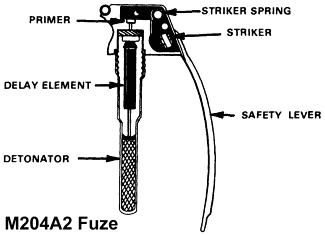
These fuzes are used with the M26, M26A1, and M61 fragmentation grenades. The delay element is a powder train requiring 4 to 5 seconds to burn to the detonator. The detonator sets off the filler.
-
M206A2.
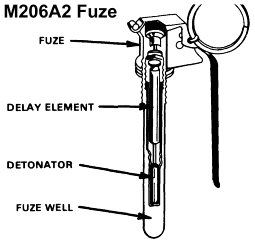
This fuze is used with the MK3A2 offensive hand grenade, commonly referred to as the concussion grenade. The M206-series of fuzes is similar to the M204-series, except for the safety lever. The M206 has a straight safety lever, while the M204 safety lever is curved. The delay element is a powder train requiring 4 to 5 seconds to burn to the detonator.
-
M213 fuze.

The M213 fuze is designed for use with the M67 fragmentation grenade. It has a safety clip. The standard delay element is a powder train requiring 4 to 5 seconds to burn to the detonator. In some cases, the delay element may vary from less than 4 seconds to more than 5 seconds due to defective fuzes.
Unit cost: $5.73 (Fiscal Year 2005).
-
M228 fuze. The M228 fuze is used with the M69 practice grenade to replicate the fuze delay of the M67 fragmentation hand grenade. The time delay element is a powder train with a 4- to 5-second delay burn. In some cases, however, the delay element may vary from less than 4 seconds to more than 5 seconds due to defective fuzes.
This is a training unique item; not used in combat.
Type Classification Date: 1971. Unit cost: $4.16 (Fiscal Year 2005).
-
C12 integral fuze.
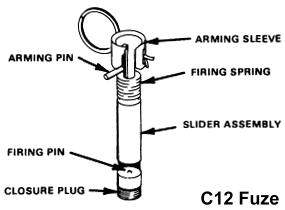
This fuze is an integral part of the M25-series riot control hand grenades. The fuze consists of a firing pin (screwed to the base of the grenade body), an arming sleeve, and a slider assembly. The slider assembly contains a delay element of 1.4 to 3 seconds and a small detonator. It functions as follows:
-
When the safety pin is removed, the arming sleeve is held in place with the thumb.
-
When the arming sleeve is released, the slider assembly is forced downward toward the firing pin under pressure of the firing spring.
-
At the bottom of the fuze well, the slider strikes the firing pin and ignites the delay element which, in turn, sets off the detonator.
-
The detonator bursts the grenade body and disperses the riot control agent over an area about 5 meters in diameter.
-
-
-
Igniting Fuze. Igniting fuzes are designed for use with chemical hand grenades. They burn at high temperatures and ignite the chemical filler.
-
M201A1 pyrotechnic delay-igniting fuze.
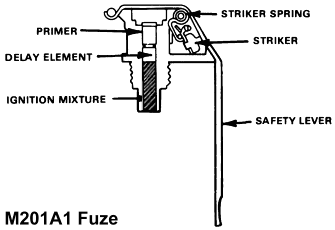
The M201A1 is designed for use with the AN-M83HC white smoke grenade, the AN-M14 TH3 incendiary grenade, and the M18 colored smoke grenade. This fuze is interchangeable with any standard firing device. The time delay element is a powder train requiring 1.2 to 2 seconds to burn to the igniter. The igniter ignites the filler or a pyrotechnic starter with a violent burning action and expels the filler from the grenade body.
-
M201A1 MOD 2. Designed to be non-fragmenting. Used on the ABC-M7A2 CS, ABC-M7A3 CS, and M84 stun hand grenades.
-
M201A1-1.
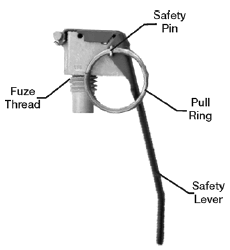
Used on the GG04 rubber ball grenade and the GG05 practice grenade body.
-
HAND GRENADES
Model |
Type |
Body |
Filler |
Fuze |
Weight |
Throwing Range |
Effect |
|---|---|---|---|---|---|---|---|
ABC-M7A2 |
riot control |
sheet metal cylinder |
5.5 oz (156 g) of burning mixture and 3.5 oz (99 g) of CS in gelatin capsules |
M201A1, M201A1 MOD2 |
15.5 oz (439 g) |
131 ft (40 m) |
Cloud of irritant agent for 15 to 35 seconds |
ABC-M7A3 |
riot control |
sheet metal cylinder |
7.5 oz (213 g) of burning mixture and 4.5 oz (128 g) of pelletized CS agent |
M201A1, M201A1 MOD2 |
15.5 oz (439 g) |
131 ft (40 m) |
Cloud of irritant agent for 15 to 35 seconds |
ABC-M25A1*, ABC-M25A2* |
riot control |
compressed fiber or plastic sphere |
CS1 or CN1 mixed with silica aerogel |
C12 |
7.5 to 8 oz (213 to 227 g) |
164 ft (50 m) |
Bursting radius: 16 ft (5 m) |
AN-M8 |
white smoke |
sheet steel cylinder |
19 oz (539 g) of Type C, HC smoke mixture |
M201A1 |
24 oz (680 g) |
100 ft (30 m) |
Emits a dense cloud of white smoke for 105 to 150 seconds |
AN-M14 |
incendiary |
sheet metal cylinder |
26.5 oz (751 g) of thermate (TH3) mixture |
M201A1 |
32 oz (907 g) |
82 ft (25 m) |
Can burn through 1/2 in (12.7 mm) steel plate |
AN-M83 |
white smoke |
2.5 in (64 mm) diameter, 5.7 in (145 mm) long, thin sheet metal cylinder |
11 oz (312 g) of terephthalic acid (TA) |
M201A1 |
16 oz (454 g) |
? |
Cloud of white smoke for 25 to 70 seconds |
GG04 |
non-lethal |
3.12 in (79 mm) diameter rubber sphere |
100 .25 in (6.4 mm) hard rubber pellets |
M201A1-1 |
10.2 oz (290 g) |
50 ft (15 m) |
Max range: 50 ft (15 m). Effective range: 6 to 10 ft (2 to 3 m) |
GG05 |
practice |
3.12 in (79 mm) diameter rubber sphere |
N/A |
M201A1-1 |
7.3 oz (208 g) |
50 ft (15 m) |
N/A |
M15 |
smoke |
sheet metal |
15 oz (425 g) of white phosphorus (WP) |
M206A2 |
31 oz (879 g) |
100 ft (30 m) |
Bursting radius: 56 ft (17 m)
|
M18 |
colored smoke |
sheet steel cylinder |
11.5 oz (326 g) of colored smoke mixture (red, yellow, green, or violet) |
M201A1 |
19 oz (538 g) |
115 ft (35 m) |
Cloud of colored smoke for 50 to 90 seconds with average burn time of 60 seconds |
M26*, M26A1* |
frag |
cast iron |
flaked or granular TNT |
M204A1 or M204A2 |
21 oz (595 g) |
131 ft (40 m) |
Casualty radius: 50 ft (15 m) |
M47 |
riot control |
3.5 in (89 mm) diameter rubber sphere |
6.5 oz (185 g) of CS pyrotechnics granulated mix |
M227 |
14.5 oz (410 g) |
115 to 150 ft (35 to 45 m) |
1,615 ft² (150 m²) of irritant agent
|
M61 |
frag |
thin sheet metal |
5.5 oz (156 g) of Composition B HE |
M204A1 or M204A2 |
16 oz (454 g) |
131 ft (40 m) |
Casualty radius: 50 ft (15 m)
|
M67 |
frag |
2.5 in (64 mm) steel sphere with a scored steel spring for fragmentation |
6.5 oz (184 g) of Composition B HE |
M213 |
14 oz
|
115 ft
|
Casualty radius: 50 ft (15 m)
|
M69 |
practice |
steel sphere |
N/A |
M228 |
14 oz (397 g) |
131 ft (40 m) |
Emits a small puff of white smoke |
M83 |
training |
? |
16 oz (454 g) of smoke mixture |
? |
? |
? |
? |
M84 |
non-lethal |
5.25 in (133 mm) long, steel hexagon tube |
? |
M201A1, M201A1 MOD2 |
13.3 oz (377 g) |
? |
Emits intense light and sound |
MK2* |
frag |
cast iron |
flaked or granular TNT |
M204A1 or M204A2 |
21 oz (595 g) |
100 ft (30 m) |
Bursting radius: 33 ft (10 m) |
MK3A2 |
offensive |
fiberglass cylinder |
8 oz (227 g) of TNT |
M206A1 or M206A2 |
15.6 oz (442 g) |
131 ft (40 m) |
Casualty radius: 7 ft (2 m) |
No. 5 Mark I Mills* |
frag |
cast iron |
? |
seperate igniter |
22.5 oz (638 g) |
at least 90 ft (27 m) |
? |
XM102 |
training |
steel hexagon tube |
? |
? |
? |
? |
? |
Grenade, Hand, Riot, CS, ABC-M7A2
Grenade, Hand, Riot, CS, ABC-M7A3
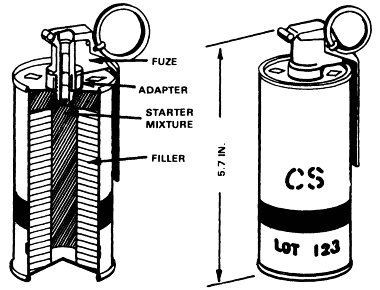 The ABC-M7A2 and ABC-M7A3 riot-control hand grenades contain only CS as a filler. They differ only in the amount of filler and the form of the CS they contain. The ABC-M7A2 grenade has 5.5 ounces of burning mixture and 3.5 ounces of CS in gelatin capsules. The ABC-M7A3 has 7.5 ounces of burning mixture and 4.5 ounces of CS pellets.
The ABC-M7A2 and ABC-M7A3 riot-control hand grenades contain only CS as a filler. They differ only in the amount of filler and the form of the CS they contain. The ABC-M7A2 grenade has 5.5 ounces of burning mixture and 3.5 ounces of CS in gelatin capsules. The ABC-M7A3 has 7.5 ounces of burning mixture and 4.5 ounces of CS pellets.
The bodies of both grenades are sheet metal with four emission holes at the top and one at the bottom. Both grenades have gray bodies with red bands and markings. These grenades do not have safety clips.
ABC-M7A3 Unit cost: $175 (Fiscal Year 2005).
Grenade, Hand, Riot, CN1, ABC-M25A1
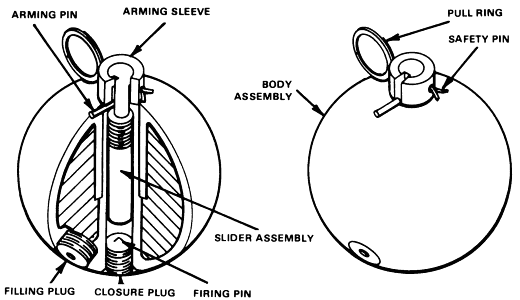 Obsolete. The ABC-M25A1 riot control hand grenade is a bursting munition with an integral fuze.
Obsolete. The ABC-M25A1 riot control hand grenade is a bursting munition with an integral fuze.
All fillers are mixed with silica aerogel for increased dissemination efficiency.
The M25 series of riot-control hand grenades have a radius burst (visible cloud grenade) of about 16 feet (5 m), but fragments of the grenade are occasionally projected up to 82 feet (25 m).
The grenade has a gray body with red band and red markings.
Grenade, Hand, Riot, CN1, ABC-M25A2
Grenade, Hand, Riot, CS1, ABC-M25A2
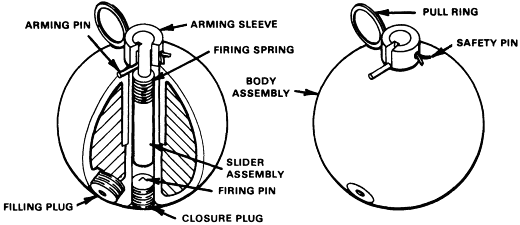

ABC-M25A2 CS1 Obsolete. The ABC-M25A2 riot control hand grenade is a bursting munition with an integral fuze. The M25A2 grenade is an improved version of the M25A1 grenade. The two grenades differ primarily in body construction.
All fillers are mixed with silica aerogel for increased dissemination efficiency.
The M25 series of riot-control hand grenades have a radius burst (visible cloud grenade) of about 16 feet (5 m), but fragments of the grenade are occasionally projected up to 82 feet (25 m).
The grenade has a gray body with red band and red markings.
Grenade, Hand, Smoke, HC, AN-M8
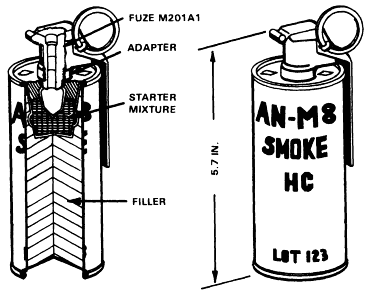 The AN-M8 HC grenade is used to produce dense clouds of white smoke for signaling and screening. Note that this grenade was listed as obsolete in the September 2000 FM 3-23.30, while the latest June 2005 release of the manual lists the grenade as currently in service.
The AN-M8 HC grenade is used to produce dense clouds of white smoke for signaling and screening. Note that this grenade was listed as obsolete in the September 2000 FM 3-23.30, while the latest June 2005 release of the manual lists the grenade as currently in service.
WARNING: The AN-M8 HC grenade produces harmful hydrochloric fumes that irritate the eyes, throat, and lungs. It should not be used in closed-in areas unless soldiers are wearing protective masks.
WARNING: Damaged AN-M8 HC grenades that expose the filler are hazardous. Exposure of the filler to moisture and air could result in a chemical reaction that will ignite the grenade.
The grenade has a light green body with black markings and a white top.
Grenade, Hand, Incendiary, TH3, AN-M14
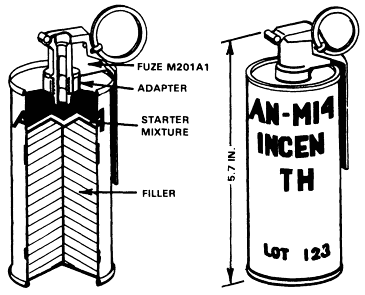 The AN-M14 TH3 incendiary hand grenade is used to destroy equipment or start fires. It can also damage, immobilize, or destroy vehicles, weapons systems, shelters, or munitions.
The AN-M14 TH3 incendiary hand grenade is used to destroy equipment or start fires. It can also damage, immobilize, or destroy vehicles, weapons systems, shelters, or munitions.
A portion of thermate mixture is converted to molten iron, which burns at 4,000° Fahrenheit. The mixture fuzes together the metallic parts of any object that it contacts. Thermate is an improved version of thermite, the incendiary agent used in hand grenades during World War II. The thermate filler can burn through a 1/2-inch homogenous steel plate. It produces its own oxygen and burns under water.
WARNING: Avoid looking directly at the incendiary hand grenade as it burns. The intensity of the light is hazardous to the retina and can cause permanent eye damage.
The grenade is gray in color with purple markings and a single purple band (current grenades). Under the standard color-coding system, incendiary grenades are light red with black markings. This grenade does not have a safety clip.
Grenade, Hand, White Smoke, TA, AN-M83
 The AN-M83 TA white smoke hand grenade is used for screening the activities of small units and for ground-to-air signaling.
The AN-M83 TA white smoke hand grenade is used for screening the activities of small units and for ground-to-air signaling.
The grenade has a forest green body with light green markings, a blue band, and a white top.
Grenade, Hand, Rubber Ball, Non-Lethal, GG04
The GG04 rubber ball grenade is used in crowd control situations where the use of non-lethal force is desired. The rubber ball grenade is designed to be hand-thrown or muzzle-launched from a 12-gauge shotgun.
The GG04 is a multiple projectile, flash-bang grenade with 100 .25-caliber hard rubber pellets. The grenade has a fuze delay of 2.8 to 3 seconds with a flash measuring approximately 1 million CP and 180 decibels at 3.5 feet. At detonation, rubber pellets are dispatched at 360° with an effective range of 2 to 3 meters and a maximum engagement range of 15 to 20 meters.
The grenade body is a rubber sphere that contains a fuze well liner.
The grenade is black with white lettering.
Fielded: 1998. Unit cost: $30 (Marine Corps Fiscal Year 2003).
Grenade, Hand, Practice, Non-Lethal, GG05
The GG05 is designed to replicate the live GG04 rubber ball grenade. It is made of durable rubber and can be hand-thrown or muzzle-launched from the 12-gauge shotgun. The body can be reloaded up to 25 times and is a component of a practice grenade assembly, consisting of the body and a M201A1-1 practice grenade fuze.
The grenade body is a rubber sphere that contains a fuze well liner and is filled with .50 caliber rubber pellets. The rubber ball pellets remain within the body.
The GG05 is blue in color. The fuze has a blue safety lever with a brown stripe.
This is a training unique item; not used in combat.
Fielded: 2002. Unit cost: $11 (Marine Corps Fiscal Year 2003).
Grenade, Hand, Smoke, WP, M15
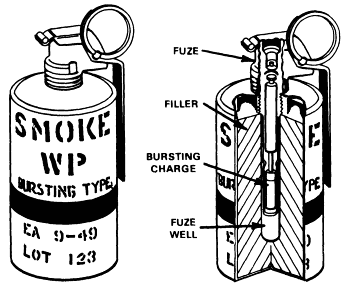 The M15 white phosphorous grenade is a bursting type grenade used for signaling, screening, and incendiary purposes.
The M15 white phosphorous grenade is a bursting type grenade used for signaling, screening, and incendiary purposes.
WARNING: All friendly personnel within the 56 foot (17 m) bursting radius should be in a covered position to avoid being struck by burning particles. The WP filler burns for about 60 seconds at a temperature of 5,000° Fahrenheit. This intense heat causes the smoke produced by the grenade to rise quite rapidly, especially in cool climates. This makes the M15 grenade less desirable for use as a screening agent.
The grenade is grey with one yellow band and yellow markings.
Grenade, Hand, Smoke, Green, M18
Grenade, Hand, Smoke, Yellow, M18
Grenade, Hand, Smoke, Violet, M18
Grenade, Hand, Smoke, Red, M18
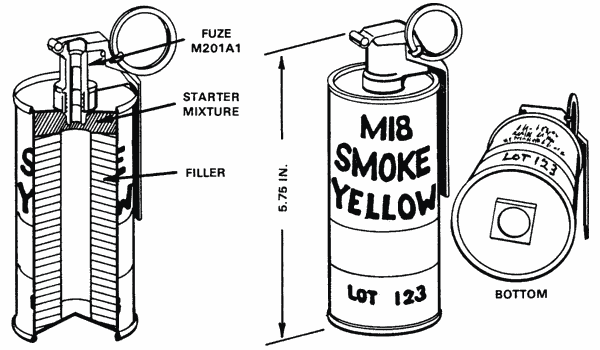 The M18 colored smoke hand grenade is used for ground-to-air or ground-to-ground signaling.
The M18 colored smoke hand grenade is used for ground-to-air or ground-to-ground signaling.
The body consists of a sheet steel cylinder with emission holes:
-
Four emission holes at the top and one at the bottom (older production).
-
Four emission holes at the top and none at the bottom (more recent production).
-
No top emission holes and one taped bottom hole (current and recent production).

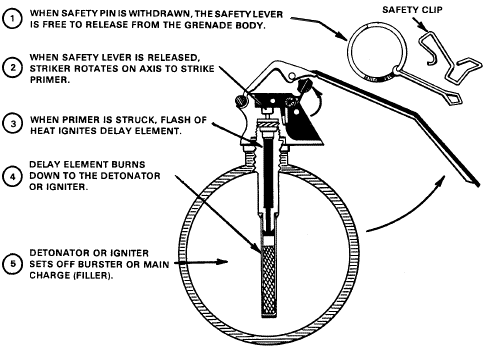
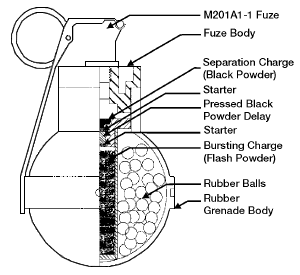
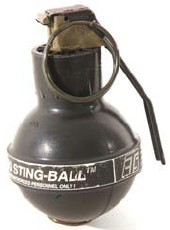
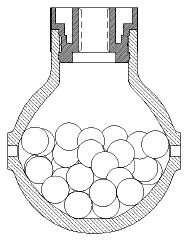
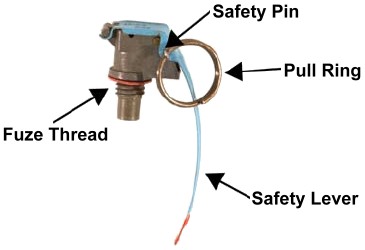

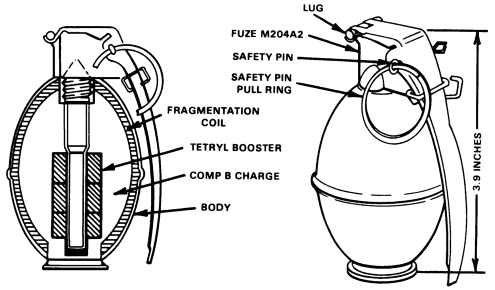 Obsolete. These grenades are used to supplement small arms fire against an enemy in close combat. They produce casualties through the high-velocity projection of fragments.
Obsolete. These grenades are used to supplement small arms fire against an enemy in close combat. They produce casualties through the high-velocity projection of fragments.  The M47 grenade is a special-purpose, burning type munition used for the control of riots and counterinsurgencies. This grenade is a nonlethal, incapacitating type munition that contains non-persistent CS agent.
The M47 grenade is a special-purpose, burning type munition used for the control of riots and counterinsurgencies. This grenade is a nonlethal, incapacitating type munition that contains non-persistent CS agent. 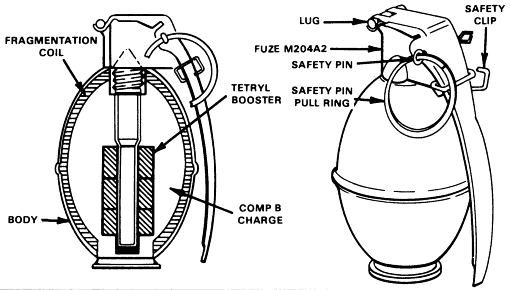 This type of grenade was developed to replace the earlier model fabricated with a deeply serrated cast iron body (the pineapple World War I grenade).
This type of grenade was developed to replace the earlier model fabricated with a deeply serrated cast iron body (the pineapple World War I grenade). 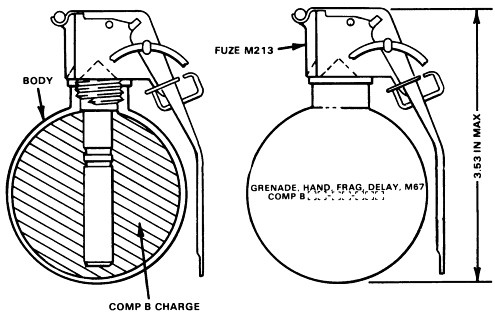 WARNING: Although the killing radius of this fragmentation grenade is 16 feet (5 m) and the casualty-producing radius is 50 feet (15 m), fragmentation can disperse as far away as 755 feet (230 m).
WARNING: Although the killing radius of this fragmentation grenade is 16 feet (5 m) and the casualty-producing radius is 50 feet (15 m), fragmentation can disperse as far away as 755 feet (230 m). 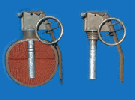
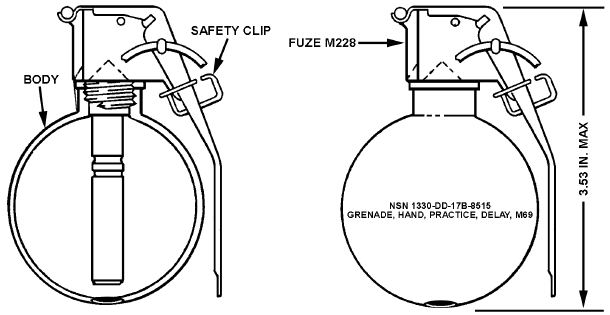 The M69 practice hand grenade simulates the M67 series of fragmentation hand grenades for training purposes. The grenade provides realistic training and familiarizes the soldier with the functioning and characteristics of the fragmentation hand grenade.
The M69 practice hand grenade simulates the M67 series of fragmentation hand grenades for training purposes. The grenade provides realistic training and familiarizes the soldier with the functioning and characteristics of the fragmentation hand grenade. 
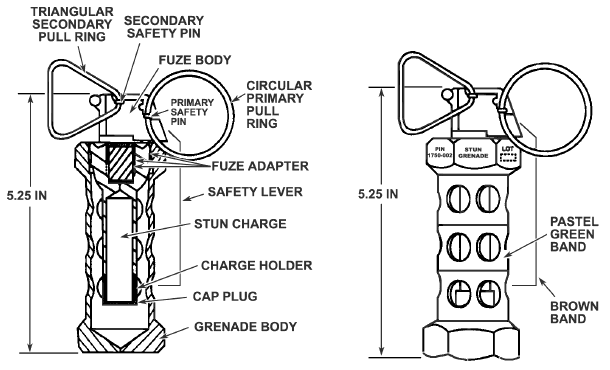 The M84 diversionary/flash-bang stun hand grenade is designed to be thrown into a room (through an open door, a standard glass window, or other opening) where it delivers a loud bang (170 to 180 decibels at 5 feet) and bright flash (1.5 to 2.5 million CP) sufficient to temporarily disorient personnel in the room.
The M84 diversionary/flash-bang stun hand grenade is designed to be thrown into a room (through an open door, a standard glass window, or other opening) where it delivers a loud bang (170 to 180 decibels at 5 feet) and bright flash (1.5 to 2.5 million CP) sufficient to temporarily disorient personnel in the room. 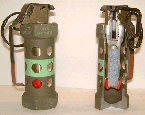
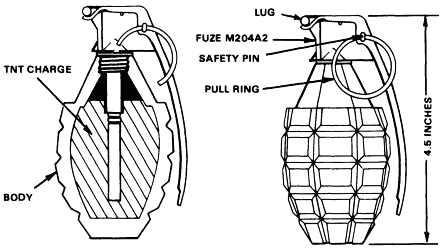 Obsolete. The MK2 is used to supplement small arms fire against the enemy in close combat. The grenade produces casualties by high-velocity projection of fragments.
Obsolete. The MK2 is used to supplement small arms fire against the enemy in close combat. The grenade produces casualties by high-velocity projection of fragments. 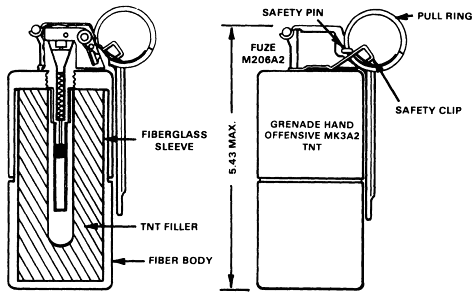 The MK3A2 offensive hand grenade, commonly referred to as the concussion grenade, is designed to produce casualties during close combat while minimizing danger to friendly personnel. The grenade is also used for concussion effects in enclosed areas, for blasting, and for demolition tasks. The shock waves (overpressure) produced by this grenade when used in enclosed areas are greater than those produced by the fragmentation grenade. It is, therefore, very effective against enemy soldiers located in bunkers, buildings, and fortified areas.
The MK3A2 offensive hand grenade, commonly referred to as the concussion grenade, is designed to produce casualties during close combat while minimizing danger to friendly personnel. The grenade is also used for concussion effects in enclosed areas, for blasting, and for demolition tasks. The shock waves (overpressure) produced by this grenade when used in enclosed areas are greater than those produced by the fragmentation grenade. It is, therefore, very effective against enemy soldiers located in bunkers, buildings, and fortified areas. 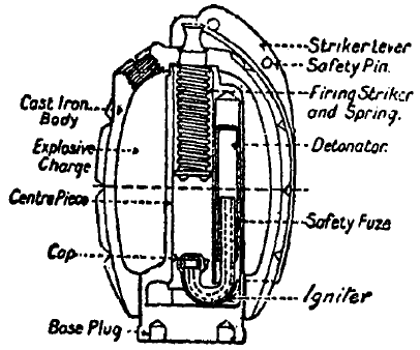 "Mills' Hand Grenade (Time)," "Mills grenade," "Mills bomb." Obsolete. WWI-era British grenade.
"Mills' Hand Grenade (Time)," "Mills grenade," "Mills bomb." Obsolete. WWI-era British grenade. 
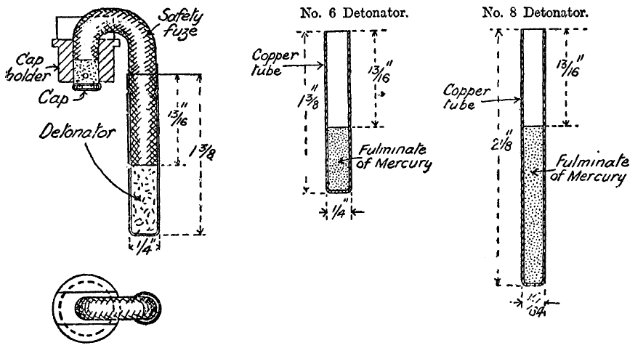
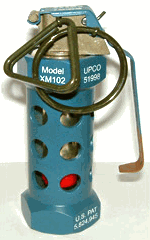
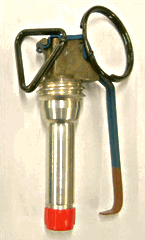 The XM102 Reloadable Stun Practice Hand Grenade (RSPHG) is the reloadable trainer for the M84 Stun Hand Grenade. It offers realistic characteristics of the M84 to assist in the training of missions such as hostage rescue or capture of criminals, terrorists or other adversaries.
The XM102 Reloadable Stun Practice Hand Grenade (RSPHG) is the reloadable trainer for the M84 Stun Hand Grenade. It offers realistic characteristics of the M84 to assist in the training of missions such as hostage rescue or capture of criminals, terrorists or other adversaries.